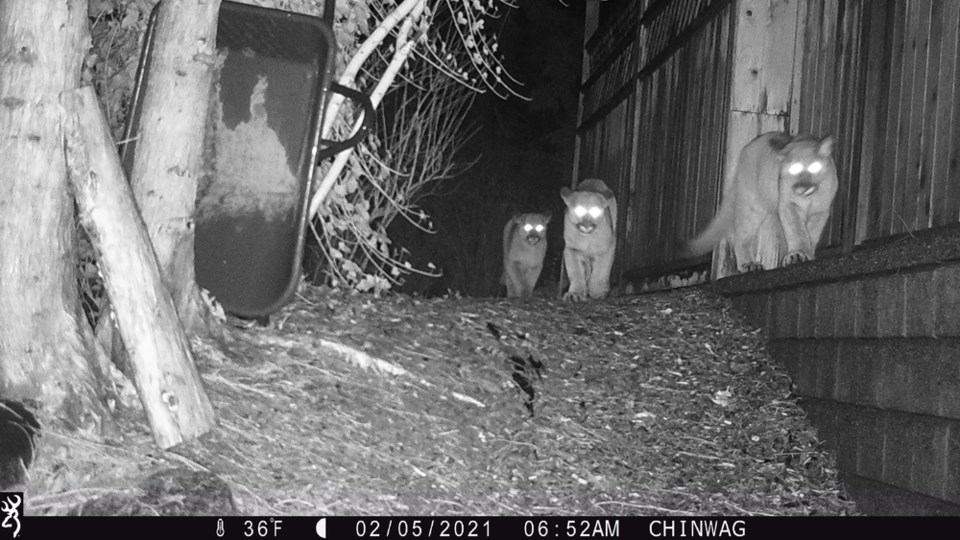Over the last five weeks, cougars have been on what feels like a puppy snatching rampage, grabbing a pug out of a Coquitlam backyard and killing two dogs in the Port Moody area this week.
In the latest attack, a cougar pounced on a German Shepherd puppy tapped to become part of Coquitlam Search and Rescue’s K-9 search team. All told, there have been at least five attacks against local dogs in what acting Sgt. Alicia Starks of the BC Conservation Officer Service described as a definite “increase in incidents this year.”
"I don’t know the exact science behind it,” she said following the death of the Port Moody dog, begging the question: What's with all these cougar attacks in the Tri-Cities?
HEIGHT OF COUGAR SEASON
Winter months are notorious for an uptick in cougar sightings in Metro Vancouver’s suburbs.
As the temperature dips at high elevations, cougars work their way down streams and creeks to prey on grazing deer, making urban areas that border and climb forested mountain slopes particular hot spots for the big cats.
Luci Cadman, a certified bear viewing guide and executive director of the North Shore Black Bear Society, said her group has worked extensively over the last several years to expand its education program to include cougars.
Working with BCIT wildlife conflict expert Tom Saare, the group has looked to reduce risk in the community and has reached out to partners in Coquitlam to spread the word.
Cadman said that despite the rise in cougar attacks in the Tri-Cities over the last five weeks, attacks on humans are extremely rare, and North America-wide data shows 27 fatal encounters over the last 100 years.
“What we do see quite often with bears as well, it’s the juvenile animals, females with young, or old that seek the periphery,” said Cadman. “They’re in urban areas looking for food opportunities and to seek safety.”
PANDEMIC TRAIL PRESSURES
The chance a human and a cougar will meet each other on a trail, roadside or backyard has gone up as development pushes into the interface between urban and wild landscapes.
Feeding backyard birds and pets outside only serves to increase that risk: the food attracts the small animals, like squirrels and racoons, that cougars prey on.
But the pandemic has also flooded trails as people follow public health recommendations to seek respite in the outdoors. In January, monthly visits to popular regional parks skyrocketed compared to the same period last year.
At Belcarra Regional Park, visits nearly tripled, whereas Colony Farm and Minnekhada regional parks saw at least twice the number of visits.
RISE IN PET OWNERSHIP
The sheer number of people outside has upped the chance of running into the elusive cats, said Cadman. But so too has a marked rise in pet ownership as people seek companionship in isolation.
“I’ve noticed the huge increase in people having pets,” she said. “…a huge increase in people that are not used to being in wilderness.”
Cats and dogs clearly fit the prey profile of a cougar. But attacks against such pets, while appearing to be on the rise, don’t indicate a habituated animal if it still gets scared away by an owner.
“We’re just introducing more domestic animals to the landscape. That just increases opportunity. That’s a risk we’re going to have to accept living in this habitat,” said Cadman, adding, “It is devastating, of course, to pet owners.”
DON’T JUST BLAME NEWCOMERS
Cadman said part of what accounts for a rise in cougar sightings comes from the growing access to trail and security cameras.
And while often an easy out, blame cannot always be put on newcomers to the suburbs of the North Shore and the Tri-Cities, who are unaware they share their neighbourhood with large predators.
“Certainly, there is a knowledge gap there,” said Cadman. “But we often find as well that some of the people that are failing to act on the advice are people who have lived here for 30 or 40 years, people who have lived here a long time near streams and the edge of forests.”
NO SILVER BULLET
There’s no one factor that would eliminate the chance of a violent encounter with a cougar. Large societal forces, like development encroaching into previously forested habitat and the rise in pet ownership, can at times seem like unstoppable juggernauts.
But anyone frequenting the trails of the North Shore and Tri-Cities, or living in its mountainside neighbourhoods can take precautions to lower the collective risk of a deadly encounter.
At home, that means eliminating pet food and birdseed feeders from your backyard. The BC Conservation Officer Service recommends pet owners don’t walk their dogs at night, and when on a walk, to keep them on a tight leash. An outdoor cat, says the service, is just one more target for a juvenile cougar learning to hunt.
“People know that bears come and eat garbage. They know bears get shot for that,” said Cadman.
In the case of cougars, she stressed, removal of the animal doesn’t mean removal of the species.
“It just leaves a void another animal will fill.”




